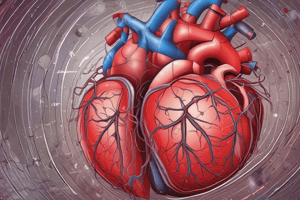Podcast
Questions and Answers
What is the characteristic criterion for hypertension?
What is the characteristic criterion for hypertension?
- Blood pressure ≥ 160/110 mmHg
- Blood pressure ≥ 150/100 mmHg
- Blood pressure ≥ 140/90 mmHg (correct)
- Blood pressure ≥ 130/80 mmHg
What percentage of hypertension cases are classified as primary hypertension?
What percentage of hypertension cases are classified as primary hypertension?
- 90-95% (correct)
- 80-90%
- 95-100%
- 5-10%
Which of the following is a risk factor for hypertension?
Which of the following is a risk factor for hypertension?
- Physical inactivity (correct)
- Physical activity
- Balanced diet
- Low sodium intake
What is a complication of uncontrolled hypertension?
What is a complication of uncontrolled hypertension?
Which type of antihypertensive drug reduces heart rate and cardiac output?
Which type of antihypertensive drug reduces heart rate and cardiac output?
What is the function of diuretics in antihypertensive therapy?
What is the function of diuretics in antihypertensive therapy?
Which type of antihypertensive drug blocks angiotensin II receptors?
Which type of antihypertensive drug blocks angiotensin II receptors?
What is the name of the drug that reduces renin production in antihypertensive therapy?
What is the name of the drug that reduces renin production in antihypertensive therapy?
Flashcards are hidden until you start studying
Study Notes
Definition and Classification
- Hypertension: a chronic medical condition characterized by elevated blood pressure (BP) ≥ 140/90 mmHg
- Classified into:
- Primary (essential) hypertension: no identifiable cause (90-95% of cases)
- Secondary hypertension: underlying medical condition or medication-induced (5-10% of cases)
Pathophysiology
- Increased peripheral resistance and/or cardiac output lead to elevated BP
- Factors contributing to hypertension:
- Genetics
- Lifestyle (e.g., physical inactivity, obesity, smoking)
- Diet (e.g., high sodium, low potassium)
- Renal disease
- Hormonal imbalances (e.g., aldosterone, cortisol)
Risk Factors and Complications
- Risk factors:
- Age > 45 years
- Family history
- Obesity
- Physical inactivity
- Smoking
- High sodium intake
- Low potassium intake
- Complications:
- Cardiovascular disease (e.g., heart failure, myocardial infarction)
- Stroke
- Chronic kidney disease
- Retinopathy
- Cognitive impairment
Antihypertensive Drugs
- Classes:
- Diuretics: increase urine production, reduce sodium reabsorption
- Thiazide diuretics (e.g., hydrochlorothiazide)
- Loop diuretics (e.g., furosemide)
- Beta blockers: reduce heart rate and cardiac output
- Non-selective (e.g., propranolol)
- Selective (e.g., metoprolol)
- Angiotensin-converting enzyme (ACE) inhibitors: block angiotensin II production
- Captopril
- Enalapril
- Angiotensin receptor blockers (ARBs): block angiotensin II receptors
- Losartan
- Valsartan
- Calcium channel blockers: relax blood vessels, reduce calcium influx
- Dihydropyridines (e.g., amlodipine)
- Non-dihydropyridines (e.g., verapamil)
- Alpha blockers: relax blood vessels, reduce peripheral resistance
- Prazosin
- Doxazosin
- Direct renin inhibitors: reduce renin production
- Aliskiren
- Vasodilators: directly relax blood vessels
- Hydralazine
- Minoxidil
- Diuretics: increase urine production, reduce sodium reabsorption
Treatment Guidelines
- Lifestyle modifications:
- Dietary changes (e.g., DASH diet)
- Weight loss
- Increased physical activity
- Smoking cessation
- Pharmacological treatment:
- Monotherapy or combination therapy
- Stepwise approach: start with low-dose, single drug, and gradually increase or add drugs as needed
- Individualize treatment based on patient characteristics, comorbidities, and response to therapy
Definition and Classification
- Hypertension is a chronic medical condition characterized by elevated blood pressure (BP) ≥ 140/90 mmHg
- Primary (essential) hypertension has no identifiable cause and accounts for 90-95% of cases
- Secondary hypertension is caused by an underlying medical condition or medication and accounts for 5-10% of cases
Pathophysiology
- Increased peripheral resistance and/or cardiac output lead to elevated BP
- Genetic factors contribute to hypertension
- Lifestyle factors contributing to hypertension include physical inactivity, obesity, and smoking
- Diet-related factors include high sodium and low potassium intake
- Renal disease and hormonal imbalances (e.g., aldosterone, cortisol) also contribute to hypertension
Risk Factors and Complications
- Risk factors for hypertension include age > 45 years, family history, obesity, physical inactivity, smoking, high sodium intake, and low potassium intake
- Cardiovascular disease, stroke, chronic kidney disease, retinopathy, and cognitive impairment are potential complications of hypertension
Antihypertensive Drugs
- Diuretics increase urine production and reduce sodium reabsorption
- Beta blockers reduce heart rate and cardiac output
- Angiotensin-converting enzyme (ACE) inhibitors block angiotensin II production
- Angiotensin receptor blockers (ARBs) block angiotensin II receptors
- Calcium channel blockers relax blood vessels and reduce calcium influx
- Alpha blockers relax blood vessels and reduce peripheral resistance
- Direct renin inhibitors reduce renin production
- Vasodilators directly relax blood vessels
Treatment Guidelines
- Lifestyle modifications for hypertension include dietary changes, weight loss, increased physical activity, and smoking cessation
- Pharmacological treatment may involve monotherapy or combination therapy
- A stepwise approach to pharmacological treatment involves starting with low-dose, single drug, and gradually increasing or adding drugs as needed
- Treatment should be individualized based on patient characteristics, comorbidities, and response to therapy
Studying That Suits You
Use AI to generate personalized quizzes and flashcards to suit your learning preferences.



